Abstract
Dentinogenesis imperfecta type II (DGI-II) is an autosomal dominant disorder of dentin formation, which has previously been mapped to chromosome 4q12-21. In the current study, six novel short tandem-repeat polymorphisms (STRPs) have been isolated, five of which show significant evidence of linkage to DGI-II. To determine the order of the STRPs and define the genetic distance between them, nine loci (including polymorphisms for two known genes) were mapped through the CEPH reference pedigrees. The resulting genetic map encompasses 16.3 cM on the sex-averaged map. To combine this map with a physical map of the region, all of the STRPs were mapped through a somatic cell hybrid panel. The most likely location for the DGI-II locus within the fixed marker map is in the D4S2691-D4S2692 interval of 6.6 cM. The presence of a marker that shows no recombination with the DGI-II phenotype between the flanking markers provides an important anchor point for the creation of physical continuity across the DGI-II candidate region.
Full text
PDF
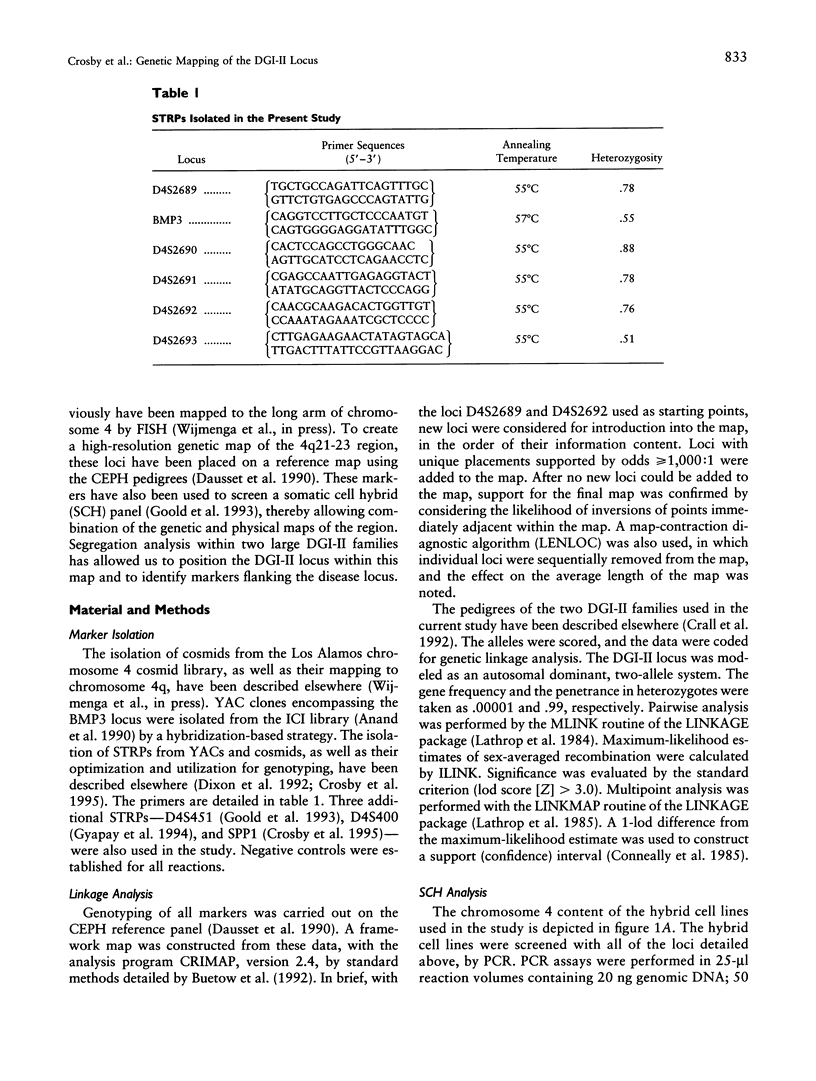
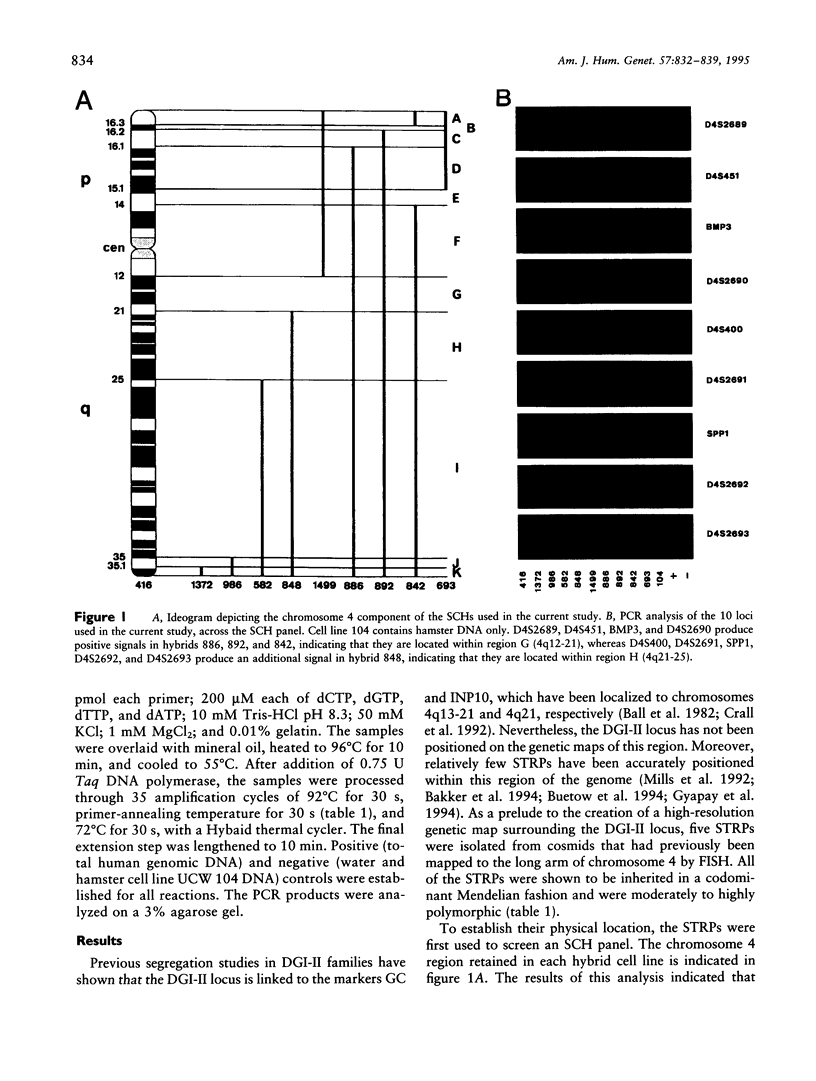
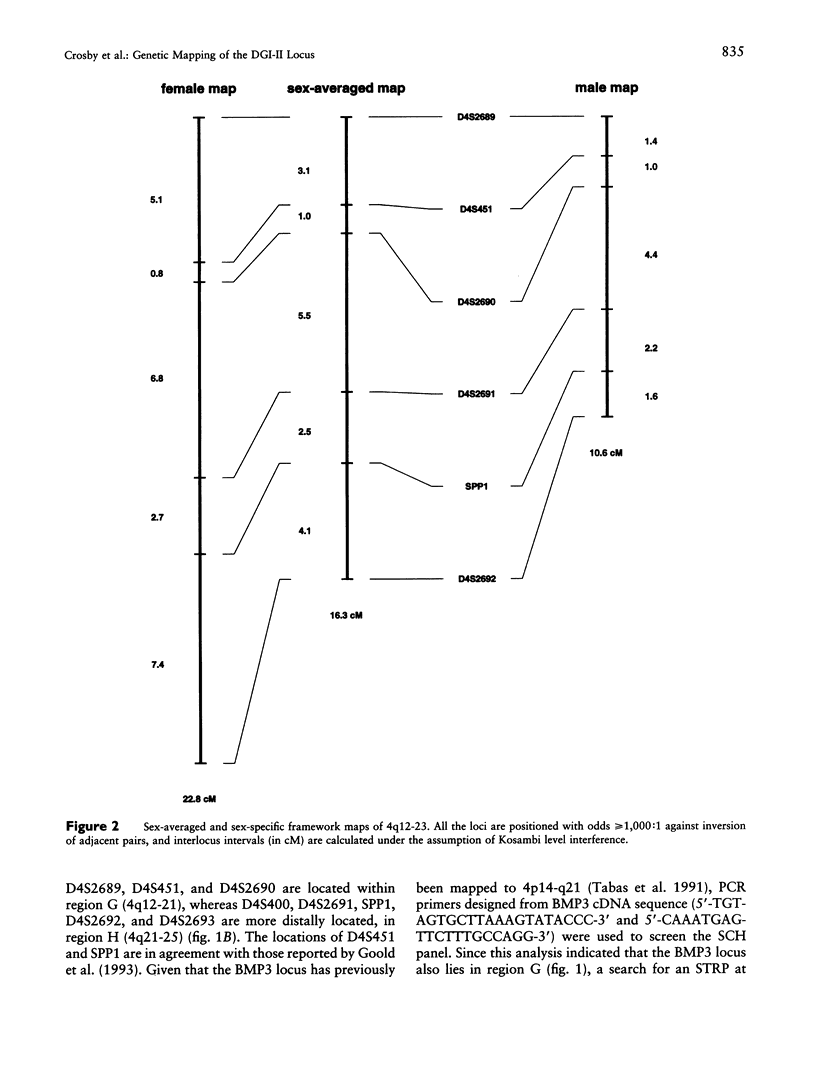
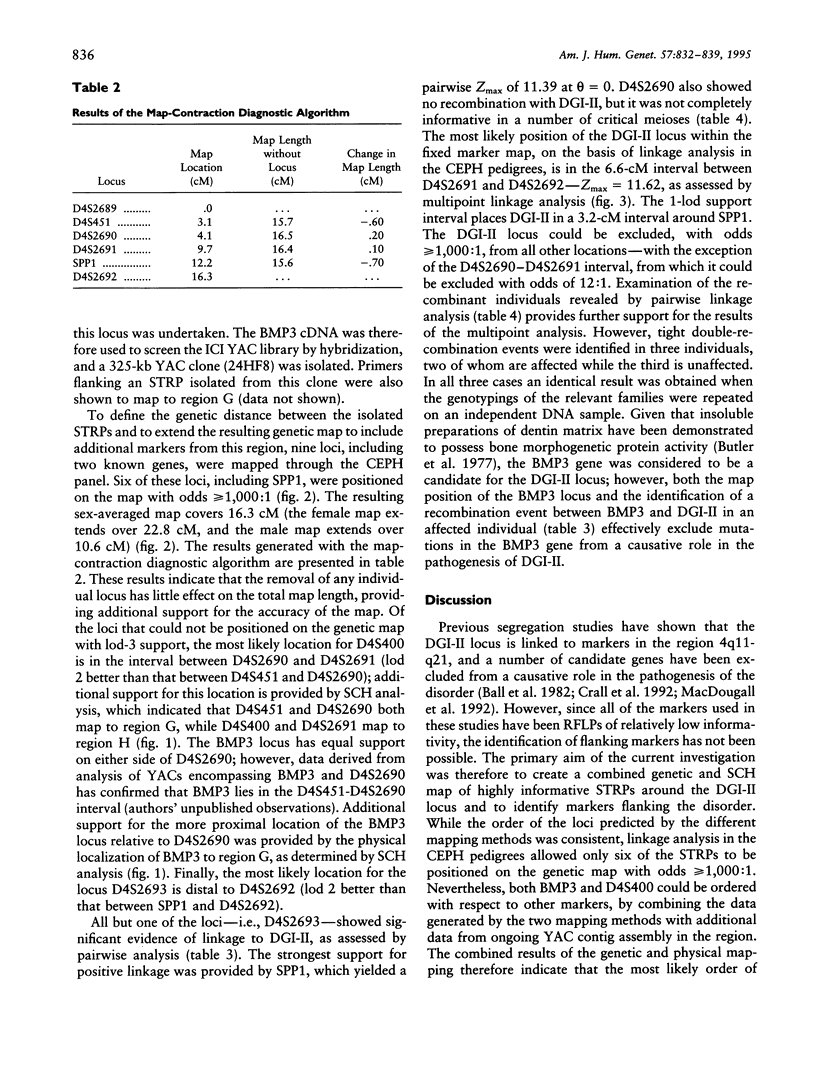
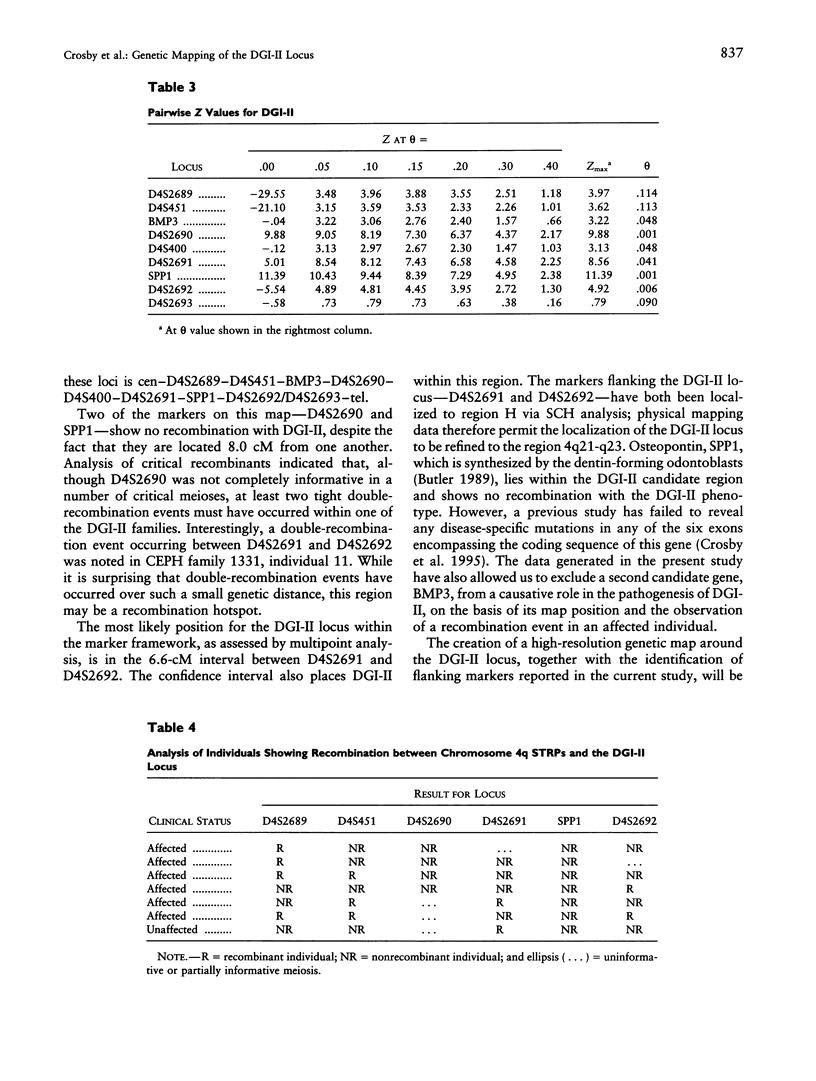
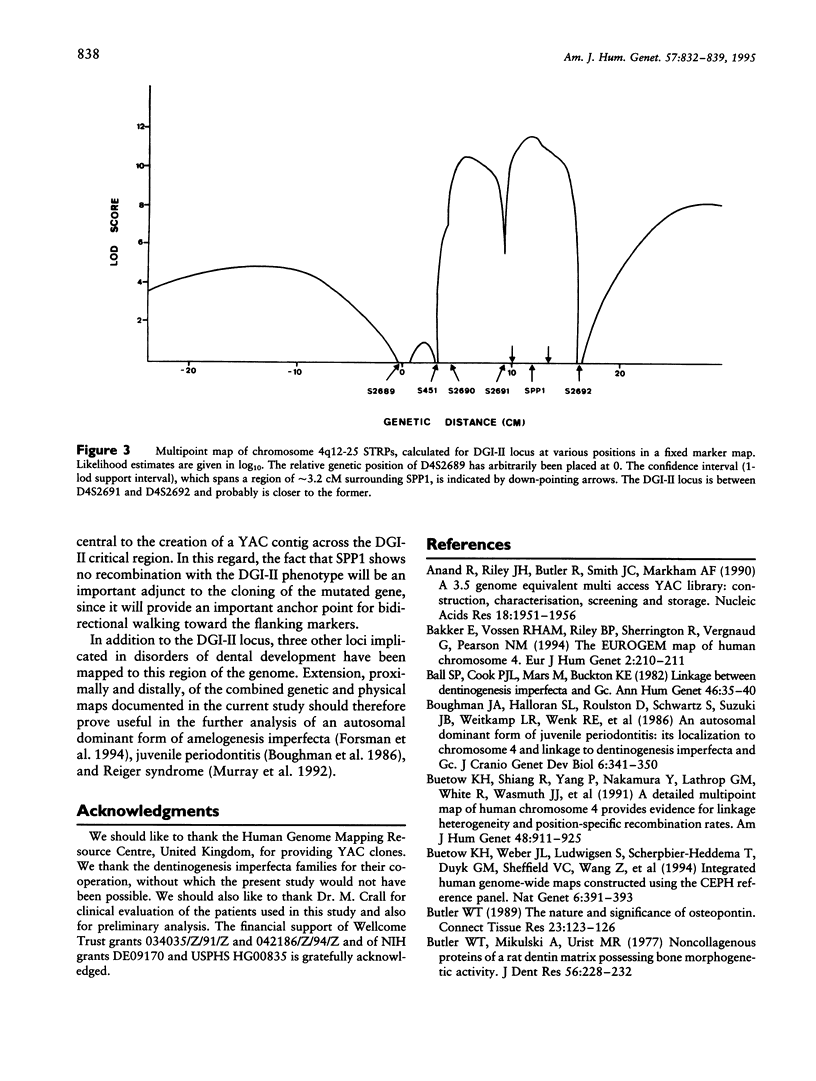
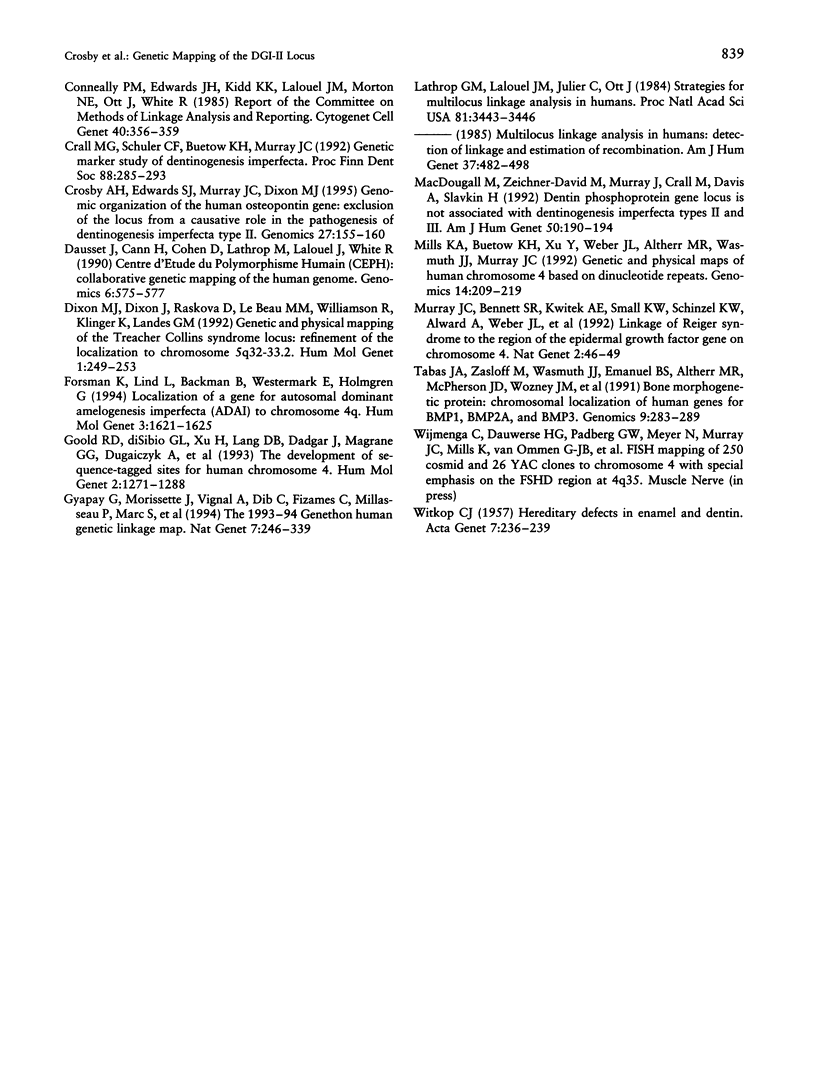
Images in this article
Selected References
These references are in PubMed. This may not be the complete list of references from this article.
- Anand R., Riley J. H., Butler R., Smith J. C., Markham A. F. A 3.5 genome equivalent multi access YAC library: construction, characterisation, screening and storage. Nucleic Acids Res. 1990 Apr 25;18(8):1951–1956. doi: 10.1093/nar/18.8.1951. [DOI] [PMC free article] [PubMed] [Google Scholar]
- Bakker E., Vossen R. H., Riley B. P., Sherrington R., Vergnaud G., Pearson N. M. The EUROGEM map of human chromosome 4. Eur J Hum Genet. 1994;2(3):210–211. [PubMed] [Google Scholar]
- Ball S. P., Cook P. J., Mars M., Buckton K. E. Linkage between dentinogenesis imperfecta and Gc. Ann Hum Genet. 1982 Jan 1;46(Pt 1):35–40. doi: 10.1111/j.1469-1809.1982.tb00693.x. [DOI] [PubMed] [Google Scholar]
- Boughman J. A., Halloran S. L., Roulston D., Schwartz S., Suzuki J. B., Weitkamp L. R., Wenk R. E., Wooten R., Cohen M. M. An autosomal-dominant form of juvenile periodontitis: its localization to chromosome 4 and linkage to dentinogenesis imperfecta and Gc. J Craniofac Genet Dev Biol. 1986;6(4):341–350. [PubMed] [Google Scholar]
- Buetow K. H., Shiang R., Yang P., Nakamura Y., Lathrop G. M., White R., Wasmuth J. J., Wood S., Berdahl L. D., Leysens N. J. A detailed multipoint map of human chromosome 4 provides evidence for linkage heterogeneity and position-specific recombination rates. Am J Hum Genet. 1991 May;48(5):911–925. [PMC free article] [PubMed] [Google Scholar]
- Buetow K. H., Weber J. L., Ludwigsen S., Scherpbier-Heddema T., Duyk G. M., Sheffield V. C., Wang Z., Murray J. C. Integrated human genome-wide maps constructed using the CEPH reference panel. Nat Genet. 1994 Apr;6(4):391–393. doi: 10.1038/ng0494-391. [DOI] [PubMed] [Google Scholar]
- Butler W. T., Mikulski A., Urist M. R., Bridges G., Uyeno S. Noncollagenous proteins of a rat dentin matrix possessing bone morphogenetic activity. J Dent Res. 1977 Mar;56(3):228–232. doi: 10.1177/00220345770560030601. [DOI] [PubMed] [Google Scholar]
- Butler W. T. The nature and significance of osteopontin. Connect Tissue Res. 1989;23(2-3):123–136. doi: 10.3109/03008208909002412. [DOI] [PubMed] [Google Scholar]
- Conneally P. M., Edwards J. H., Kidd K. K., Lalouel J. M., Morton N. E., Ott J., White R. Report of the Committee on Methods of Linkage Analysis and Reporting. Cytogenet Cell Genet. 1985;40(1-4):356–359. doi: 10.1159/000132186. [DOI] [PubMed] [Google Scholar]
- Crall M. G., Schuler C. F., Buetow K. H., Murray J. C. Genetic marker study of dentinogenesis imperfecta. Proc Finn Dent Soc. 1992;88 (Suppl 1):285–293. [PubMed] [Google Scholar]
- Crosby A. H., Edwards S. J., Murray J. C., Dixon M. J. Genomic organization of the human osteopontin gene: exclusion of the locus from a causative role in the pathogenesis of dentinogenesis imperfecta type II. Genomics. 1995 May 1;27(1):155–160. doi: 10.1006/geno.1995.1018. [DOI] [PubMed] [Google Scholar]
- Dausset J., Cann H., Cohen D., Lathrop M., Lalouel J. M., White R. Centre d'etude du polymorphisme humain (CEPH): collaborative genetic mapping of the human genome. Genomics. 1990 Mar;6(3):575–577. doi: 10.1016/0888-7543(90)90491-c. [DOI] [PubMed] [Google Scholar]
- Dixon M. J., Dixon J., Raskova D., Le Beau M. M., Williamson R., Klinger K., Landes G. M. Genetic and physical mapping of the Treacher Collins syndrome locus: refinement of the localization to chromosome 5q32-33.2. Hum Mol Genet. 1992 Jul;1(4):249–253. doi: 10.1093/hmg/1.4.249. [DOI] [PubMed] [Google Scholar]
- Forsman K., Lind L., Bäckman B., Westermark E., Holmgren G. Localization of a gene for autosomal dominant amelogenesis imperfecta (ADAI) to chromosome 4q. Hum Mol Genet. 1994 Sep;3(9):1621–1625. doi: 10.1093/hmg/3.9.1621. [DOI] [PubMed] [Google Scholar]
- Goold R. D., diSibio G. L., Xu H., Lang D. B., Dadgar J., Magrane G. G., Dugaiczyk A., Smith K. A., Cox D. R., Masters S. B. The development of sequence-tagged sites for human chromosome 4. Hum Mol Genet. 1993 Aug;2(8):1271–1288. doi: 10.1093/hmg/2.8.1271. [DOI] [PubMed] [Google Scholar]
- Gyapay G., Morissette J., Vignal A., Dib C., Fizames C., Millasseau P., Marc S., Bernardi G., Lathrop M., Weissenbach J. The 1993-94 Généthon human genetic linkage map. Nat Genet. 1994 Jun;7(2 Spec No):246–339. doi: 10.1038/ng0694supp-246. [DOI] [PubMed] [Google Scholar]
- Lathrop G. M., Lalouel J. M., Julier C., Ott J. Strategies for multilocus linkage analysis in humans. Proc Natl Acad Sci U S A. 1984 Jun;81(11):3443–3446. doi: 10.1073/pnas.81.11.3443. [DOI] [PMC free article] [PubMed] [Google Scholar]
- MacDougall M., Zeichner-David M., Murray J., Crall M., Davis A., Slavkin H. Dentin phosphoprotein gene locus is not associated with dentinogenesis imperfecta types II and III. Am J Hum Genet. 1992 Jan;50(1):190–194. [PMC free article] [PubMed] [Google Scholar]
- Mills K. A., Buetow K. H., Xu Y., Weber J. L., Altherr M. R., Wasmuth J. J., Murray J. C. Genetic and physical maps of human chromosome 4 based on dinucleotide repeats. Genomics. 1992 Oct;14(2):209–219. doi: 10.1016/s0888-7543(05)80208-3. [DOI] [PubMed] [Google Scholar]
- Murray J. C., Bennett S. R., Kwitek A. E., Small K. W., Schinzel A., Alward W. L., Weber J. L., Bell G. I., Buetow K. H. Linkage of Rieger syndrome to the region of the epidermal growth factor gene on chromosome 4. Nat Genet. 1992 Sep;2(1):46–49. doi: 10.1038/ng0992-46. [DOI] [PubMed] [Google Scholar]
- Tabas J. A., Zasloff M., Wasmuth J. J., Emanuel B. S., Altherr M. R., McPherson J. D., Wozney J. M., Kaplan F. S. Bone morphogenetic protein: chromosomal localization of human genes for BMP1, BMP2A, and BMP3. Genomics. 1991 Feb;9(2):283–289. doi: 10.1016/0888-7543(91)90254-c. [DOI] [PubMed] [Google Scholar]
- WITKOP C. J. Hereditary defects in enamel and dentin. Acta Genet Stat Med. 1957;7(1):236–239. doi: 10.1159/000150974. [DOI] [PubMed] [Google Scholar]



